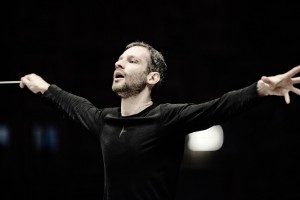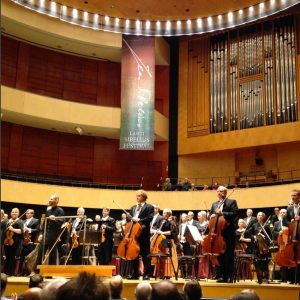The Lahti Symphony Orchestra’s Sibelius Festival 2016 marked the beginning of a new era: the start of Dima Slobodeniouk’s tenure as principal conductor of the orchestra and artistic director of the festival.
The festival is now in its seventeenth year and took place on 8–11 September. For listeners it marked a leap into the unknown. Slobodeniouk’s predecessors as artistic directors of the festival – Osmo Vänskä, Jukka-Pekka Saraste and Okko Kamu – all had established credentials as Sibelius conductors, as did 2015’s guest conductors Leif Segerstam and Sakari Oramo. But Slobodeniouk was an unknown quantity: although he can be heard conducting Sibelius in a couple of YouTube videos, he has by no means profiled himself as a Sibelius specialist.

Dima Slobodeniouk (b. 1975) studied the violin at the Moscow Central Music School; after that he attended the Moscow Conservatory School of Music and the Keski-Suomen konservatorio in Jyväskylä, then at the Sibelius Academy as a pupil of Olga Parhomenko. In the conducting class at the Sibelius Academy his teachers included Leif Segerstam, Jorma Panula and Esa-Pekka Salonen.
From the first moment that he came onstage, it was clear that Slobodeniouk is an energetic and dynamic conductor. Key elements of his interpretations were flexibility and clarity – flexibility in terms of rubato that was applied liberally yet tastefully; and clarity in the way he made sure the various sections of the orchestra, especially the strings, retained their own distinct identity as well as blending together into a homogeneous whole. Thus he focused on clean string playing (e.g. at the conclusion of Pohjola’s Daughter) and refinement of detail (the last chords of Tapiola were absolutely magical). He also drew exquisite pianissimo playing from the orchestra (e.g. in The Death of Mélisande), of a kind not heard since Osmo Vänskä was principal conductor. The way he subtly brought out the music’s various tone colours, and achieved tonal variety within a single phrase or even a single chord, was impressive indeed, and served greatly to enhance the status of the various movements from theatre scores and the shorter tone poems The Dryad and Pan and Echo. The enthusiasm of the orchestral players was evident, and the keenness of their response was clearly audible in, for example, the scherzo of the First Symphony with its notoriously tricky fugal entries, here very cleanly and accurately executed.

So everything in the garden was rosy? Not quite: the slow movement of the Fourth Symphony started slowly and atmospherically, but there was quite an abrupt gearchange to a faster tempo at letter A. Moreover, at the end of the finale the tempo dropped back to something more akin to Adagio, which not what Sibelius wrote and surely not what he intended (admittedly Okko Kamu’s Fourth at the 2011 festival was even more extreme in this respect). In the Third Symphony, the first movement was taken very briskly, with the consequence that the string playing sometimes became ragged. The slow movement, although nicely phrased and very finely balanced (three cheers for the timpani at Fig. 13) was also on the fast side, lacking the ambivalent, multi-dimensional atmosphere that conductors such as Vänskä and Segerstam realize so effectively. The finale, however, was a great success; with his wide experience of the complex rhythms of contemporary music, Slobodeniouk was especially effective in the rhythmically complex passage before the start of the march theme (Figs. 8–13).
The musicians at the two chamber concerts – pianist Johannes Piirto and the Kamus Quartet – took an approach that harmonized well with the orchestral concerts, with plenty of rubato, exuberance and vitality. Johannes Piirto, by his own admission not a specialist in Sibelius’s piano music, is definitely an artist to watch, and he interacted with the audience by presenting – in Finnish – his own view of the music: the Piano Sonata of 1893 (surely one of the most underrated of Sibelius’s piano works), the popular ‘Trees’, Op. 75, and the innovative and searching Ten Pieces, Op. 58. The pianissimos achieved by the Kamus Quartet in the slow movement of the ‘Voces intimae’ string quartet on Sunday morning were every bit as mesmerizing as the ones the full orchestra had achieved over the previous three days; and the thrilling conclusion of that work had an almost symphonic intensity, its final D minor chords as remorseless as the A minor ending of the Fourth Symphony two nights earlier.
Among the ‘extra-curricular’ activities enjoyed by members of Sibelius One during the festival were a visit to Sibelius’s home Ainola in Järvenpää (where our Annual General Meeting took place on 8 September); a reception hosted by the Sibelius Society of Finland and its president Lauri Ratia, including a thought-provoking introduction to the music in the first concert by Timo Virtanen, editor-in-chief of the Jean Sibelius Works critical edition; and our very own ‘Symposium’ on Saturday night at the restaurant El Toro in central Lahti.
© Sibelius One 2016
2016 Programmes
All orchestral concerts with the Lahti Symphony Orchestra
conducted by Dima Slobodeniouk
Orchestral concerts
Thursday 8th September 2016, 19.00 / Sibelius Hall
Pohjola’s Daughter
Tapiola
Symphony No. 1
Encores: Scene with Cranes; Polka from Suite mignonne
Friday 9th September 2016, 19.00 / Sibelius Hall
The Dryad
The Tempest, Suite No. 2
Symphony No. 4
Encores: Solitude from Belshazzar’s Feast; The Countess’s Portrait
Saturday 10th September 2016, 17.00 / Sibelius Hall
Pan and Echo
Pelléas et Mélisande
Symphony No. 3
Encore: Finlandia
Chamber Concerts
Saturday 10th September 2016, 12.30 / Kalevi Aho Hall
Sibelius’s Piano Music:
Sonata in F major, Op. 12
Five Pieces, ‘The Trees’, Op. 75
Ten Pieces, Op. 58
Johannes Piirto, piano
Sunday 11th September 2016, 11.00 / Sibelius Hall
Moderato – Allegro appassionato in C sharp minor, JS 131
Adagio in D minor, JS 12
String Quartet in D minor, Op. 56, ‘Voces intimae’
Kamus Quartet
For information about the 2017 Festival, please click here.